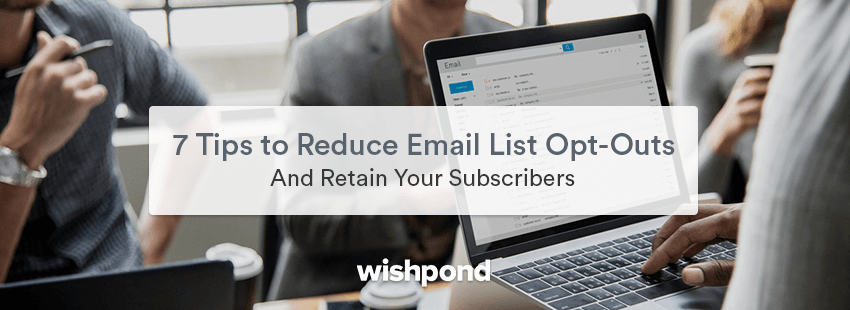When trying to grow your email list do you ever feel like you’re taking one step forward and two steps back?
Does pressing the “send” button on your email campaigns give you anxiety because you’re afraid someone on your list might unsubscribe?
Maintaining a healthy email list and preventing your subscribers from opting out is something all businesses struggle with. Fortunately there are ways you can help reduce the number of people who unsubscribe from your list.
To help maximize your efforts to build your email list, I’m going to share with you seven tips that every marketer should follow to retain as many subscribers as possible.
Follow these tips and you’ll be on your way to growing an email list that provides value for both your subscribers and your business in no time!
#1. Give Them An Option To Re-Subscribe
Sometimes people unsubscribe by accident. When they do, make it easy for them to re-subscribe.
If a subscriber enjoys your emails they might regret unsubscribing, but navigating back to your website to sign up again could be too much friction.
In that scenario you’ll want to make it easy for your subscribers to join your list again.
Give them the option to do it right from the unsubscribe confirmation screen or you can add an option to resubscribe in the unsubscribe confirmation email like G2 Crowd does in the screenshot below:
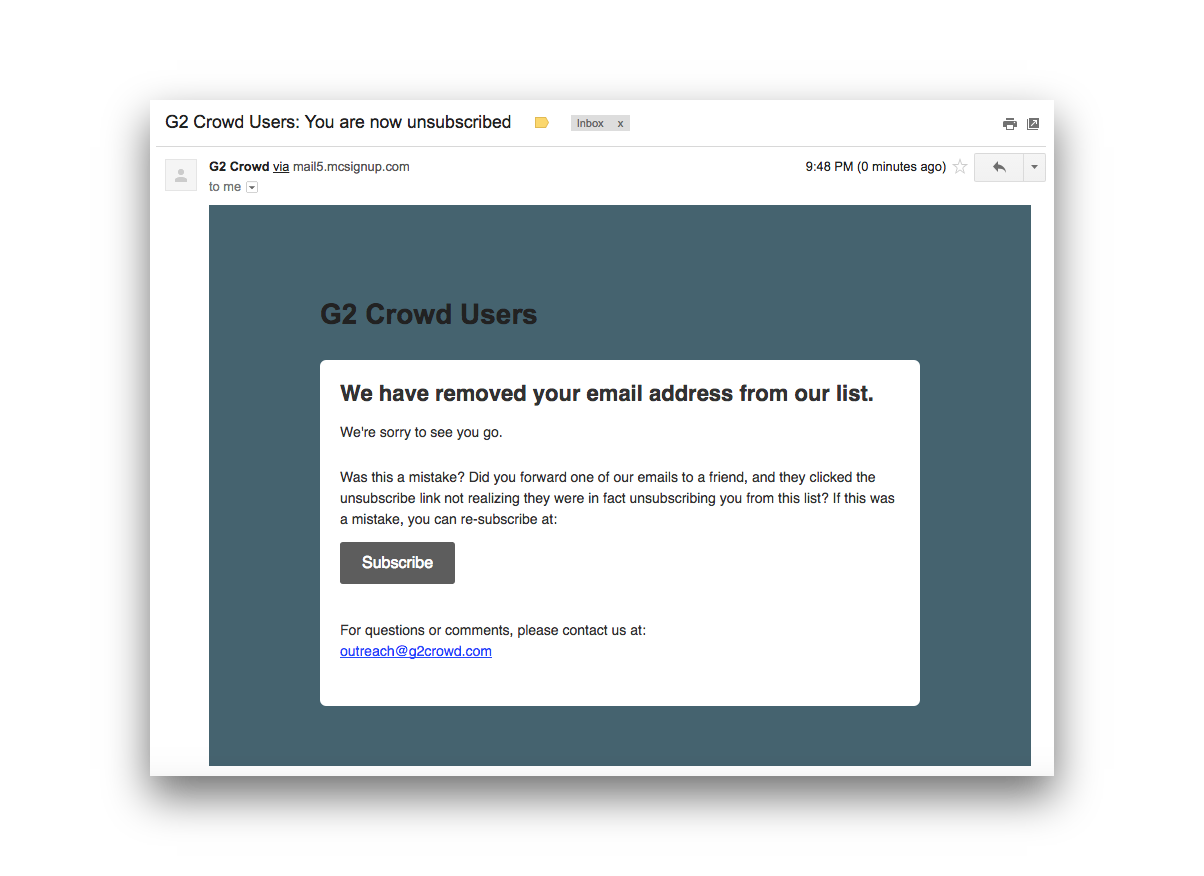
While this won’t help retain every subscriber who opts out, it will make it easy to recover those who opted out accidentally or, like the scenario that G2 uses above, when someone who you forwarded your email to opts you out unintentionally.
#2. Create An Email Preferences Center
Emailing your subscribers too often is something that you should legitimately be concerned with, but it’s important to keep in mind that everyone has a different tolerance for the amount of emails they’re willing to receive.
While receiving two emails a week might be fine for some subscribers, every person has different preferences so it could cause others on your list to unsubscribe.
To accommodate all of your subscribers’ preferences give them the ability to fine tune how often they get emails from you. This functionality is sometimes referred to as an email preferences center.
You can do this with most email service providers by creating a form that your subscribers fill out after they click on your unsubscribe link.
If they opt to receive fewer emails, rather than unsubscribing, add them to a new segment of your list which you send to less often.
Take a look at how Bonobos does that in the example below:
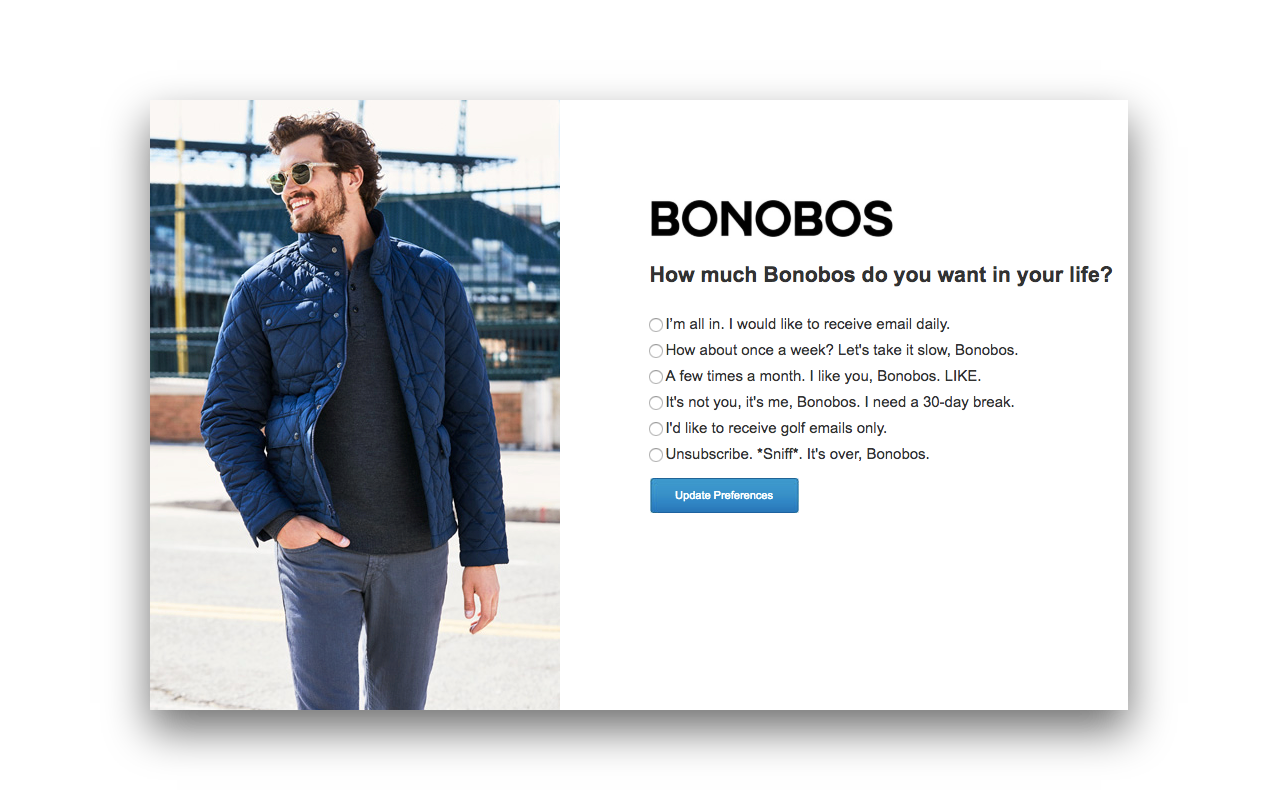
For inspiration to create a great email preferences center, check out these real world examples from the folks at Really Good Emails.
#3. Communicate Regularly
I can’t stress how important it is to keep in touch with your subscribers. Fortunately, most people feel the same way.
In a study by Marketing Sherpa, most respondents said they want to receive promotional emails from companies they do business with “at least monthly.”
Staying in regular contact with your list not only helps keep you (and the products you sell) top of mind, but it can help prevent people from unsubscribing because they won’t forget who you are.
To do this, I recommend creating a cadence that you follow so your subscribers gets used to hearing from you. Paul Jarvis does a great job of this with his “Sunday Dispatch” which he sends out every Sunday like clockwork.
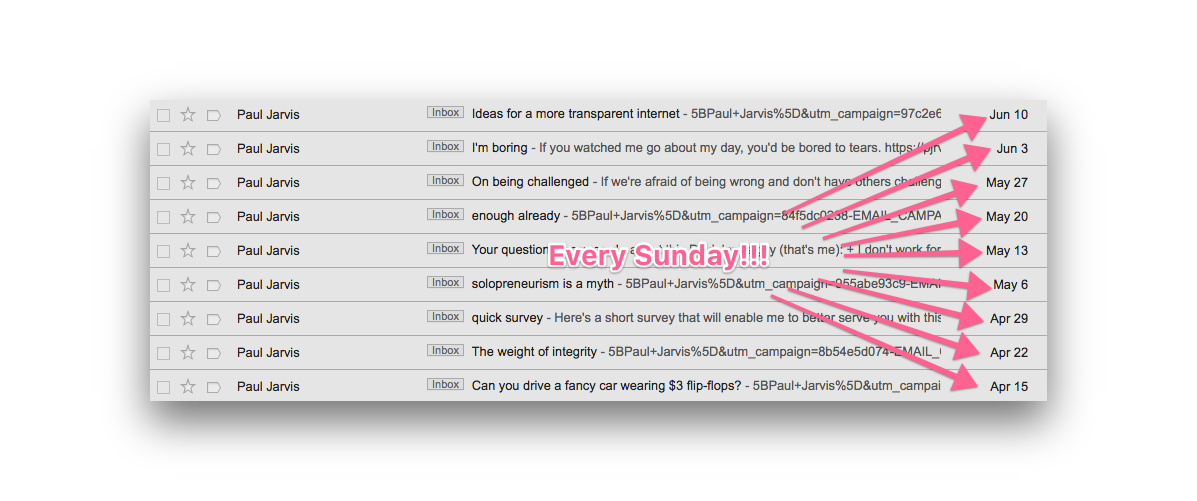
But don’t just send emails for the sake of sending them, be sure to always be adding value.
Which brings me to my next point…
#3. Always Add Value
Nobody likes being sold to, and selling through email is no exception.
If you’re constantly trying to sell something with every email you send your subscribers will get annoyed and eventually unsubscribe.
Why did they subscribe to your list in the first place? It’s because they like you, your message, or you’ve given them some sort of value in the past. Don’t cause them to lose trust in you by barraging them with emails to buy your product or service.
That being said, you can’t send emails forever without some sort of return on investment. So decide on what you think is an acceptable ratio of emails that add value versus emails that are selling.
Some people recommend a 2:1 ratio of emails that add value versus sales emails. This can vary based on industry or price however. Do you sell high ticket items? Maybe you should send even more emails which add value before you ask for the sale.
At the end of the day, you know your subscribers best. If they have a lower tolerance for being sold to then take your time and build their trust or else they might unsubscribe before you get a chance to make a sale.
#4. Don’t Look Spammy
Have you ever looked at the emails in your spam folder?
If you do, you’ll notice that many of them have the same things in common. They almost always are related to money, and they almost always come from a business name rather than a person.

In fact, one study found that 43% of recipients mark an email as spam based on the “from” name and 69% of recipients mark an email as spam based on the subject line.
So what is the takeaway from these observations?
Spam filters work pretty similarly to the way humans think. We don’t like being sold to, and we don’t like receiving emails from people we don’t recognize.
To maintain a healthy list, and prevent people from unsubscribing, don’t make the same mistakes that spammers make. Use your name, rather than your company name, and add value before asking for the sale.
Doing this will not only help prevent your emails from going straight to the spam folder but your recipients will become more familiar with you and look forward to receiving your emails rather than opting out because they’re annoyed.
#5. Personalize Your Emails
When you make your emails more personal your recipients really feel like you’re speaking to them. This helps build the relationship with your subscribers that is so important to successful email marketing.
But sending personal emails isn’t just limited to calling them by their first name. You can personalize your emails in other ways too.
By using a tone that matches your audience they’ll feel like you understand them and you’re speaking to them as a peer, as opposed to a marketer who’s trying to sell to them.
Product Hunt does a great job of doing this in their daily digest emails. In the example below, notice how they add some humor with their subject line and even include a cat GIF. The tone of this email is perfect for their target audience which is technology professionals who always appreciate a good cat GIF.
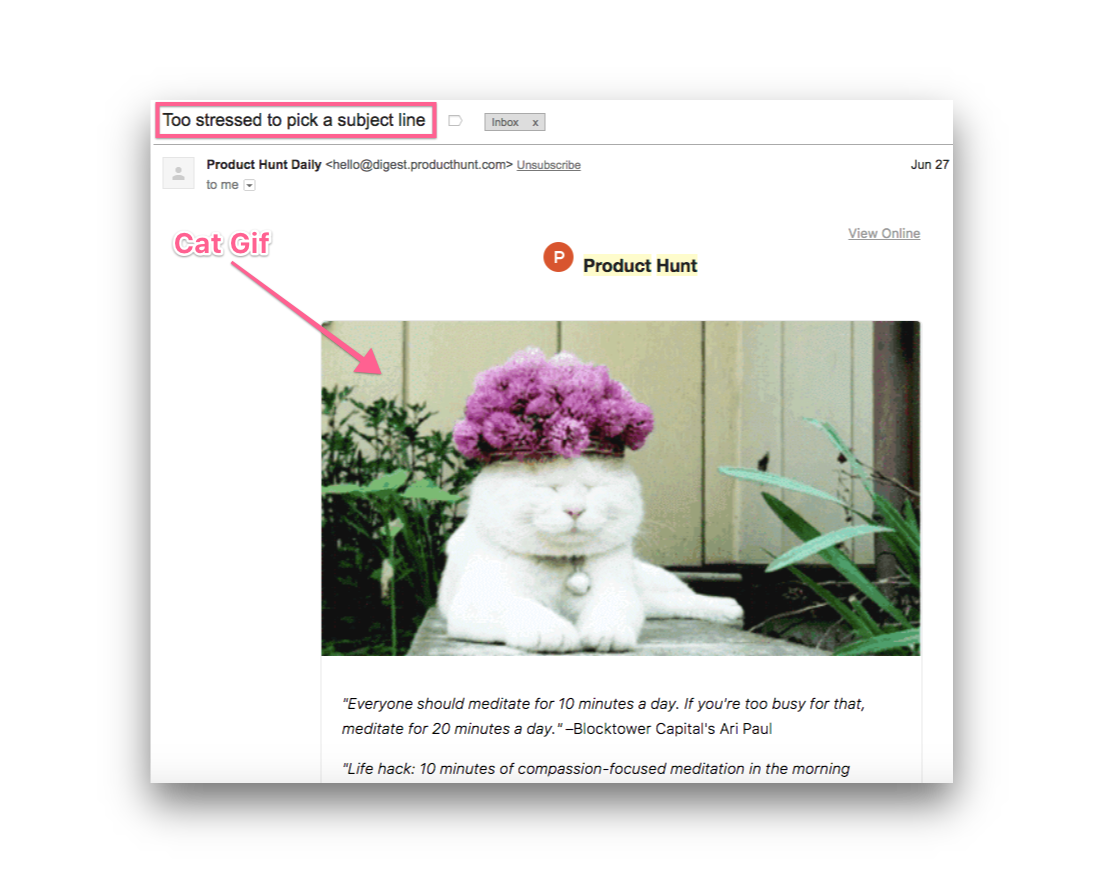
You can also personalize your emails further using merge tags in the body of the email.
With merge tags you can add extra context that is relevant to the recipient such as their interests, how or where they subscribed, or you could include their company name as well.
Anything you can think of to make your emails more personalized will go a long way towards building a connection with your subscribers so that they don’t unsubscribe from your list.
#6. Optimize Your Emails for Mobile Devices
Designing emails is a lot like designing a website or a user interface. You always want to design with your audience in mind so they have a positive experience.
Since most people open emails on their smartphone, it’s important that your emails are optimized for mobile so that reading your emails isn’t a chore.
Overlooking this type of detail when you send out your campaigns will not only hurt your campaign’s performance but it can cause unsubscribes as well. One study found that 15% of mobile users will unsubscribe from a list if the email they open isn’t optimized for mobile.
The easiest way to do this is to use an email service provider that has mobile-responsive email templates built in (like Wishpond).
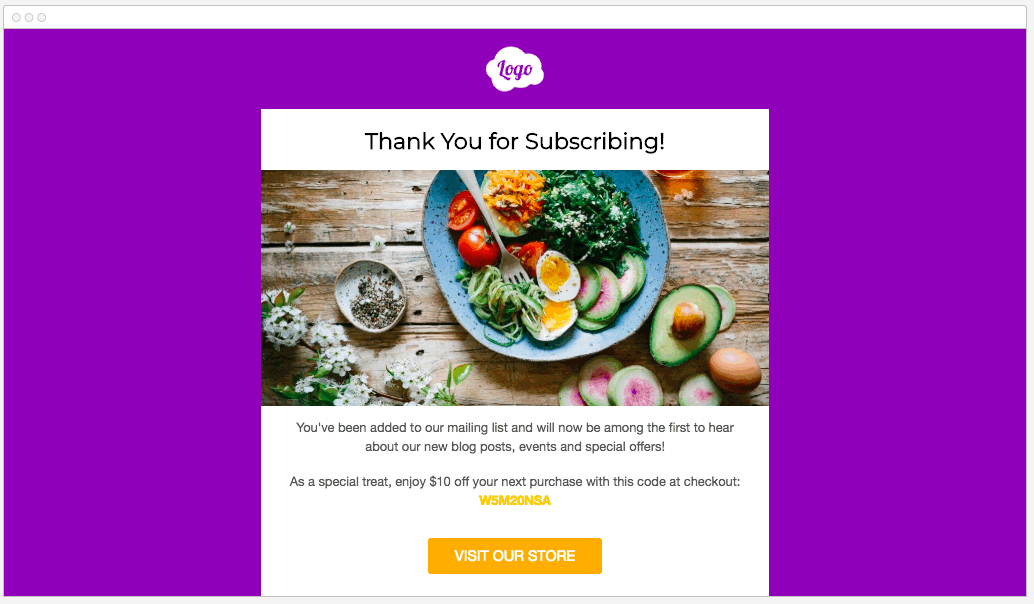
#7. Remind Them Why They’re Hearing From You
Sometimes your subscribers might forget that they opted-in to your list which can cause them to unsubscribe.
If you’re communicating regularly then it shouldn’t be an issue. If you’re not communicating regularly, refresh their memory by adding a reminder to the footer of your emails.
Some email service providers, make it easy for you to do this by adding a field in your account settings for you to create a “permission reminder” which they automatically include in the footer for you.
Mailchimp does a good job of explaining why it’s important to remind your recipient where they subscribed to your list. Here’s how they describe it:
“Sometimes people forget they signed up for an email newsletter. To prevent false spam reports, it’s best to briefly remind your recipients how they got on your list.”
Here’s an example of a simple permission reminder that I include in my emails to help remind my subscribers why they’re receiving an email from me.
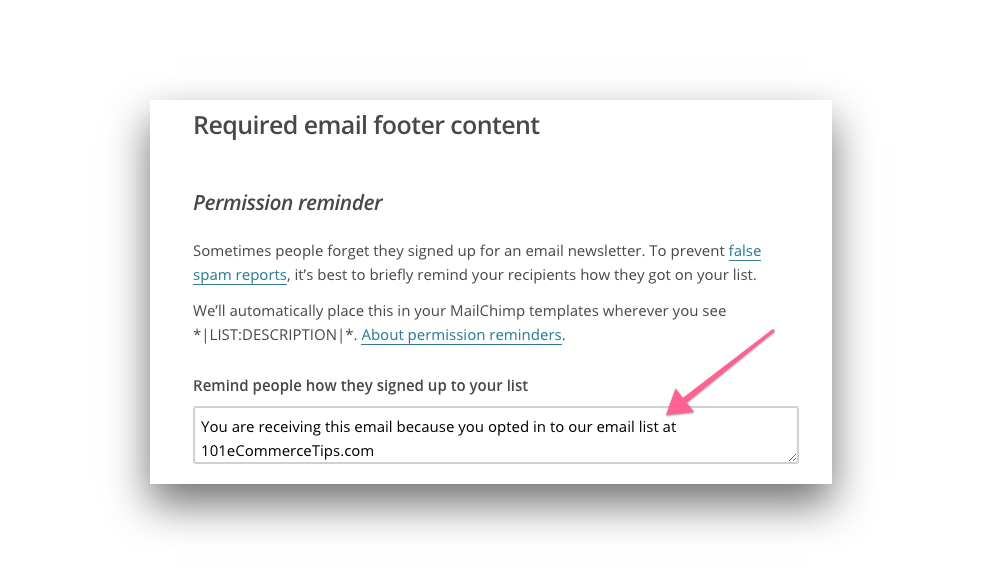
Related Content
- The Introductory Guide to Email Marketing
- The 5 Real Reasons Nobody’s Opening Your Emails
- 5 Reasons Your Email Marketing Strategy Isn’t Working (and How to Change That)
- 8 Tips to Make Unsubscribe Pages Work for You
Final Thoughts
Growing an email list is hard, especially in the beginning. Fortunately, it gets easier as you start to gain momentum, and after you observe what does and doesn’t work with your subscribers.
The seven tips I shared above are a mix of what has worked for me as well as some widely accepted best practices that many marketers follow.
If you follow these tips to create a framework for your email marketing, and when you send each campaign, you’ll be on your way to growing an email list that will pay dividends for your business.
Over To You!
Do you have any other tips to help prevent your people on your list from unsubscribing?
I’d love to hear your what works for you! Let’s chat in the comments below.

About the Author:
Michael Folling is a digital nomad, founder of Limitless Designs, and author of 101 eCommerce Tips. He enjoys building brands and writing about e-commerce and the digital nomad lifestyle.

